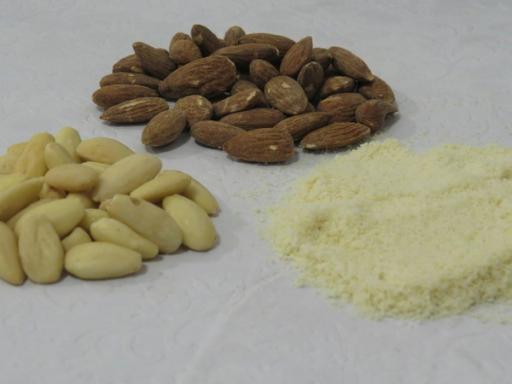
For many of us, the road to muscle growth isn’t smooth sailing. You may pack on some size at first, but eventually, the gains slow to a crawl and then stop altogether. At that point, it’s common to feel frustrated and unsure what to do. To optimize your nutrition for muscle growth, you need to find the ideal target for your macros. This article will help you with that, so you can return to making consistent, noticeable gains. So, How to Hit Your Macros?
A calorie tracker like Cal AI can help you achieve your goals by making it easier to find, hit, and adjust your macros for muscle growth.

Carbohydrates, protein, and fat all play vital roles in promoting good health and optimizing fitness. “The biggest misconception I see around macronutrients is the idea that one macro is somehow more or less important than the other,” says Desiree Nielsen, RD, a registered dietitian and the author of Eat More Plants and Good for Your Gut.
“But the reality is that our body is designed to consume all three because they all provide energy and serve different metabolic functions.” Below, learn the unique roles of each macro.
Carbs are the body’s primary fuel source, especially during exercise. “When you eat a carb-containing food—like oatmeal or a banana—the body breaks down those carbs into small, simple sugar molecules, including glucose, that go into your bloodstream and subsequently enter your cells,” explains registered dietitian Jessica Cording.
“From there, cells can convert glucose into energy in the form of ATP to help power countless biological functions necessary for survival, such as nerve impulse transmission, muscle contraction, and protein synthesis. Excess glucose not used immediately for energy may be stored as glycogen in your muscles and liver for later use, like during a workout.”
While fat and protein can also produce ATP, the body is much more efficient at converting glucose. So when you’re performing more intense physical activities that require a lot of energy quickly, think things like resistance training, HIIT workouts, sprint intervals, and indoor cycling, glucose from carb-containing foods and stored glycogen is the body’s primary ATP or energy source.
This is why nutrition experts often recommend having a pre-workout meal or snack containing carbs before intense sweat sessions.
Carbs are good for more than just energy; they can also help you preserve and build muscle. “Carbohydrates are protein-sparing, which means that when we consume enough carbohydrate, it keeps the body from burning protein [from muscle and from dietary sources] for energy,” Nielsen says. This, in turn, helps the body maintain lean muscle mass and allows dietary protein to be used for muscle protein synthesis (MPS) and other vital processes.
While you don’t want excessive amounts of macronutrients, nutrition experts say it’s not uncommon for people to hinder their fitness goals by going too low-carb. “I’ve seen clients struggle to reach their fitness and weight goals when they’re working out very intensely and restricting carbohydrates,” Cording says.
“Once they ease up a little on the intense exercise and are more intentional about rest and about eating high-quality complex carbs to support their workout routine, they start to see the results they’re after, and they tend to feel a lot better mentally, too!” Not all carb-containing foods are created equal, though. You want to focus on unrefined, minimally processed carb sources such as vegetables, fruits, whole grains, and legumes (and limit highly processed carbs like white bread, crackers, baked goods, and certain cereals).
Those minimally processed carbs are naturally rich in fiber, a type of nondigestible carbohydrate shown to:
They are a great source of micronutrients and beneficial antioxidant compounds such as polyphenols and carotenoids.
When you eat protein-rich foods like chicken breast, that protein is broken down into individual amino acids, which are absorbed into your circulation and used as “building blocks” to grow and repair every structure and tissue in the body, including:
So, adequate protein is necessary for building strength, preventing injury, and supporting a healthy outward appearance.
Consuming enough protein is particularly important for optimizing MPS, or the process by which amino acids are incorporated into skeletal muscle proteins to build and repair muscle tissue. Eating enough protein can help preserve the muscle mass you already have, while combining protein with resistance training can optimize MPS and help you build additional muscle mass.
Having a healthy amount of muscle is key for boosting performance and curbing the risk of sarcopenia (age-related muscle loss), which is associated with poor mobility and early death.
Muscles are also more metabolically active than fat, meaning you burn more calories, even at rest, when you have more muscle mass. After strenuous workouts, distributing protein intake throughout the day and consuming a balanced snack that contains protein, carbs, and healthy fats can also help optimize MPS and muscle gains.
But protein can do a lot more than build muscle. For one, including adequate protein (and fat) in meals helps stabilize post-meal blood sugar levels. In addition to curbing diabetes risk, “blood sugar balance is really important for helping you stay full and supporting stable energy and mood,” Cording says.
According to Nielsen, amino acids from proteins are also critical for supporting immune function, they’re needed to create white blood cells and antibodies to help ward off infections. Additionally, amino acids are an essential component of enzymes, proteins that catalyze every chemical reaction in the body.
Animal proteins like meat, fish, and dairy are often considered high-quality picks since they’re “complete proteins,” meaning they contain all nine essential amino acids the human body can’t make. But don’t stress if you’re a plant-based eater: You can still get all essential amino acids by consuming various plant foods (think: tofu, nuts, seeds, and beans).
Plant proteins are associated with enhanced longevity. Just aim to limit your protein intake from highly processed meats such as bacon, pepperoni, sausage, deli meats, and hot dogs, which are more strongly linked to cardiovascular disease and various cancers.
While carbs and protein often get all the hype regarding eating for optimal fitness, fat is just as crucial for overall health and well-being. Like protein, one of the most immediately noticeable benefits of including fat in your meals is that it promotes stable blood sugar and helps keep you full, Cording says.
Fats also help us absorb fat-soluble compounds in our food, from vitamins A, D, E, and K to carotenoid antioxidants and sterols (plant compounds with cholesterol-lowering properties).
Once dietary fats are broken down into fatty acids and absorbed via the lymphatic system and bloodstream, fatty acids can serve as a structural component of cells, building blocks of signaling molecules, and a concentrated source of energy (a gram of fat provides nine calories, while a gram of carb or protein provides 4).
“Fatty acids are incorporated into our cell linings, influencing both how flexible these cell linings are and the way they communicate with each other,” Nielsen says. “They are also used to build signaling molecules in the body like prostaglandins,” which play key roles in healing, blood flow, inflammatory response, menstruation, ovulation, and more.Fatty acids (from dietary or stored body fat) are also used to produce steroid hormones, including:
A 2021 meta-analysis of studies found that low-fat diets may be associated with decreased testosterone production in men compared to higher-fat diets. Healthy testosterone levels not only positively impact sexual function, but also support optimal muscle growth, bone strength, and more.
But not all sources of fat are equally beneficial. Your best bet: Focus on sources of unsaturated fats, including monounsaturated fats (MUFAs) and polyunsaturated fats (PUFAs) like omega-3s and omega-6s. Try also to minimize intake of saturated fat (SFA), which contributes to elevated LDL cholesterol, arterial plaque buildup, and inflammation.
Replacing SFAs with unsaturated fats is associated with a reduced risk of death from a variety of diseases, including cardiovascular disease and cancer.

When hitting your macros for muscle gain, a good starting point is 30% protein, 50% carbs, and 20% fats. Nevertheless, these ratios can be adjusted based on individual preferences and how your body responds to a dietary approach.
To calculate your macros for muscle gain, you first need to determine your total daily energy expenditure (TDEE). TDEE is the total number of calories your body needs to maintain weight. Several factors influence TDEE, including:
By estimating your TDEE accurately, you can adjust your calorie intake based on your muscle gain goals, such as creating a caloric surplus to support muscle growth.
That is a great question, and the answer is relatively straightforward. To maximize muscle growth, you should consume close to 1.0 grams of protein per pound of body weight.
You will also need to ensure that you consume at least 1.0 grams of carbohydrates per pound of body weight, but you may need to drink closer to 1.5-2.0 grams of carbohydrates per pound of body weight (we usually start muscle gain clients at 1.5 and then adjust from there).
Then, you can round out the rest of the calories from either fats or carbohydrates, depending on your preferences. If you adopt a lower-fat diet, just ensure you get at least 10-15% of calories from fat.
The easiest way to calculate macros is using a fitness tracking app or online macro calculator that does the math for you. To understand how each macro plays a role in your fitness, here is precisely how to set your ideal macro ratio for a lean bulk.
While building muscle in a calorie deficit is possible, these gains tend to be minimal. Thus, increasing your food intake is a great starting place for any bulk. You can determine how many calories you need a day for weight gain by learning your current daily energy expenditure (TDEE).
This would be the number of calories you need to eat to maintain weight. Remember to account for any strength training you plan to do, as this will increase your daily calorie needs. From here, you can add a calorie surplus of 5 to 15% to promote a gain of ~0.5% to 1% of your body weight per week, which for most people would be ½ a pound to 2 pounds of muscle a week.
The amount of lean weight you can gain and how quickly it depends on your starting body fat percentage, training experience, genetics, and more. If you’re new to bulking, starting at a lower calorie amount and slowly increasing every 3 to 4 weeks will help you add healthy weight.
But if you’ve got a good amount of lean muscle, to begin with, or have a hard time gaining weight, you may need to start at a more aggressive amount.
Fat is calculated first because a set percentage is typically around 30% of your calories. For example, if you need 2,500 calories/day to bulk, your fat goal would be 83 grams daily (1 gram of fat = 9 calories). (2,500 x 0.30) / 9 = 83 grams. Because fat can be an easy source of the energy needed to gain weight, increasing fat intake is one way to support muscle growth.
Nevertheless, too much fat (over 30% of calories) in some people could cause more body fat gains. Additionally, fat doesn't play quite the supportive role as carbs and protein do since it is mainly used for energy. How well you handle a high-fat diet depends on your unique metabolic needs.
The type of fat you eat might impact potential fat gain, with some research suggesting saturated fats are more likely to cause increases in fat storage compared to unsaturated, healthy fats in a calorie surplus (4). Aim to keep your fat intake at 20 to 30% of your daily intake to get the potential health benefits, but not overdo it. And opt for more healthy fats from plants and seafood where possible.
Consuming enough protein is essential for muscle gain since it is the sole source of amino acids needed to build lean tissue. It is also crucial for post-workout recovery, helping to repair muscle damage and support existing muscle mass. In addition, protein is the least likely of all the macronutrients to be stored as body fat in a calorie surplus, potentially helping to reduce body fat increases.
Your fitness level and existing muscle mass determine the amount of protein you need to build muscle. Essentially, the more muscle you have, and the more you use it, the more protein you need. Eating one gram of protein per pound of lean mass is recommended to maintain existing muscle, and slightly more to add mass.
According to the research, a high-protein diet—anywhere from 1 to 1.5 grams of protein a day, per pound of body weight—is suggested to support more muscle growth and less body fat gain in a bulking diet (5,6). For example, a 200-pound adult would need 200 to 300 grams of protein daily, with 800 to 1200 calories coming from protein (1 gram of protein = 4 calories).
Of course, the exact amount that works for you can depend on various factors. It is not always necessary to eat hundreds of grams of protein daily to see muscle gain. Aim to get about 1 gram per pound and increase to 1.5 grams per pound max as needed.
While protein is essential to building muscle, carbohydrates are also crucial. Carbohydrates can supply energy for your muscle-building workouts and may also support muscle growth in other ways, such as supporting exercise recovery and the prevention of further muscle breakdown (7).
A higher carb might also be ideal for weight gain, with some studies suggesting that high carb intake is less likely to promote fat storage than high fat intake when calorie needs are exceeded (8,9). Of course, this always depends on the person and how well/often you use carbs for energy.
To get a precise estimate, you can determine your daily carbohydrate needs by calculating your protein and fat needs first (1 gram of carbohydrate = 4 calories). For example, a 200-pound adult who needs 2500 calories, 83 grams of fat, and 200 grams of protein, would need 2500 calories - (83g of fat x 9) - (200g of protein x 4) = 953 carb calories /4 = 238 grams of carbs per day.

Diet isn’t the only factor to consider when it comes to increasing muscle mass. In addition to consuming a well-balanced diet, strength training (also called resistance training) is the most effective way to build muscle mass. Strength training is a type of exercise that increases the size and strength of your muscles.
It can include lifting free weights, using weight machines or resistance bands, and performing bodyweight exercises like squats and lunges, all contributing to muscle growth.
Rest and recovery are also just as important as training. Muscles grow and repair during rest periods, so you need to give them proper time to heal. Taking rest days in between intense workouts can help prevent overtraining and injuries. Getting sufficient sleep (7-9 hours per night) and managing stress levels can also support muscle recovery and hormone production.
You'll maximize your muscle gain potential by combining proper nutrition, strength training, and adequate rest.
Cal AI transforms calorie tracking with cutting-edge AI technology. Just snap a photo of your meal, and we'll do the rest.
Our app combines your phone's depth sensor with advanced AI models to:
With 90% accuracy on visible foods and multiple tracking options like:
We've made nutrition tracking effortless. Whether you're scanning a full meal or a quick snack, Cal AI
Our AI learns from your feedback to improve accuracy. It includes personalized insights and smart reminders to keep you on track. Cal AI makes achieving your fitness goals simpler than ever.
Track your calories with your camera using Cal AI's calorie tracker today!